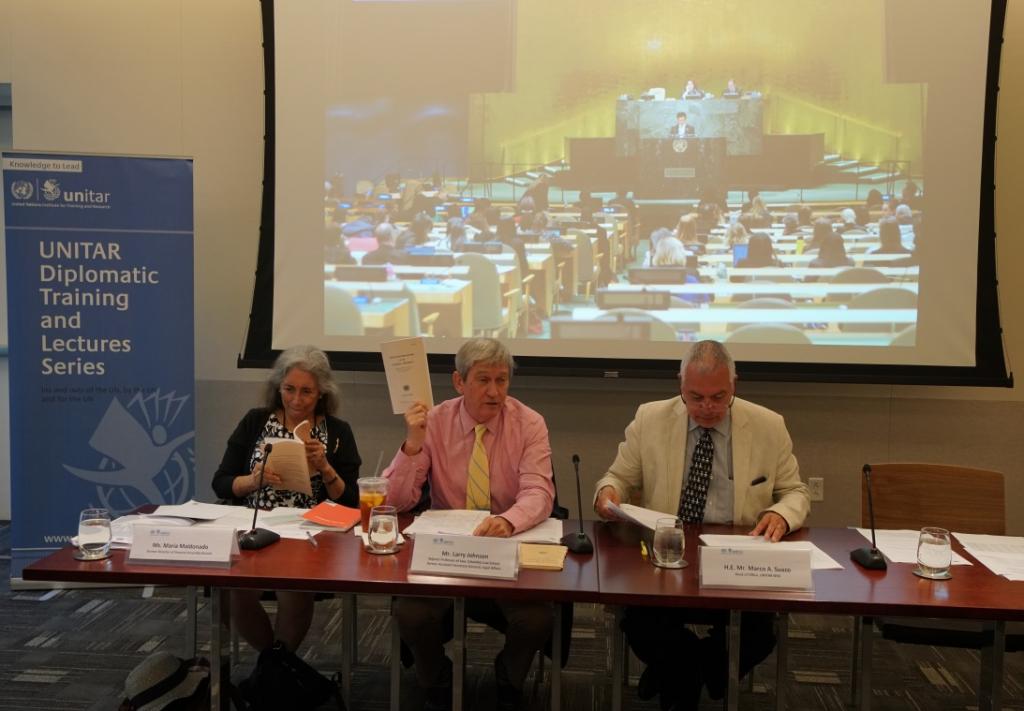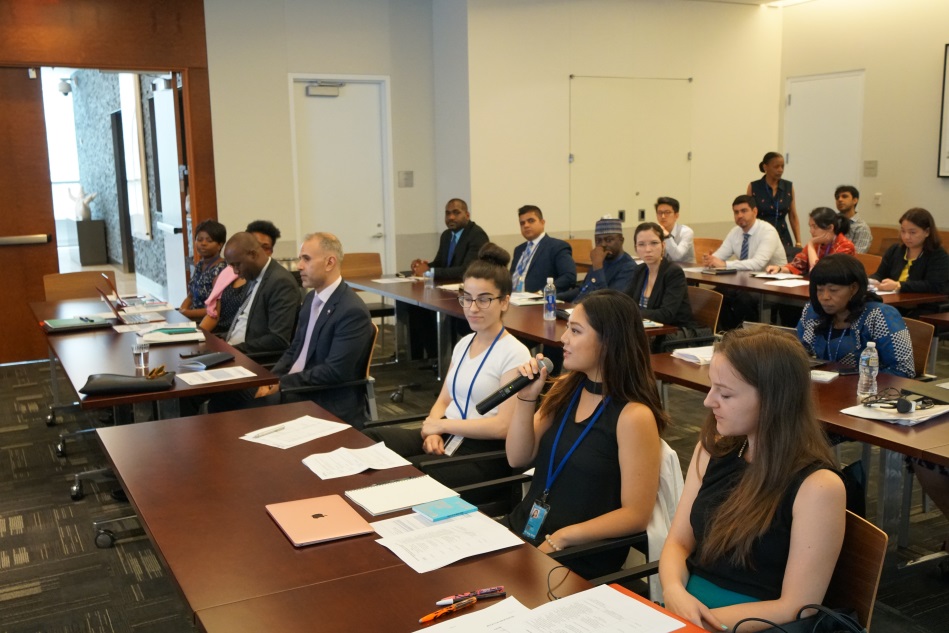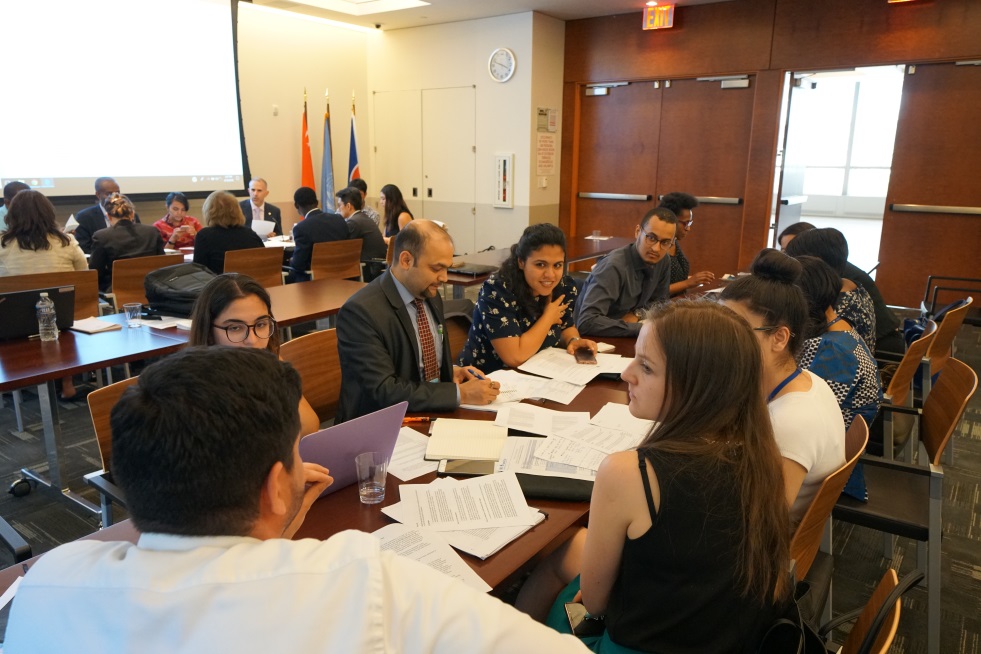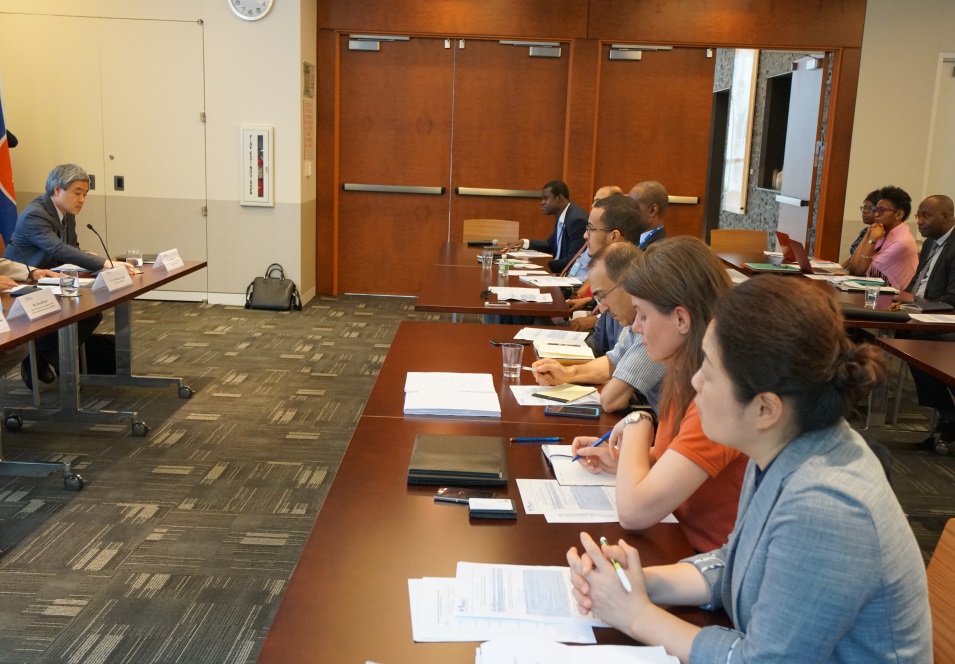Workshop on Drating Resolutions
 19-20 June 2018, New York, USA - The United Nations Institute for Training and Research's (UNITAR) New York Office organized a two-day event, “Workshop on the Structure, Drafting, and Adoption of the United Nations Resolutions” on 19-20 June 2018 in collaboration with the Permanent Mission of the Republic of Singapore and sponsored by the Permanent Mission of Sweden programme “levelling the playing field” to the United Nations. The workshop was attended by approximately 30 delegates from Permanent Missions to the UN. Mr. Marco A. Suazo, representing UNITAR’s New York Office, opened the seminar and briefed the event’s topic of UN resolutions and introduced panellists. Mr. Suazo spoke his appreciation for generous support given by the Permanent Mission of the Republic of Singapore and Sweden to the United Nations in New York, which enabled sponsored delegates from other Permanent Missions to the United Nations to attend free of charges. Mr. Suazo thanked Ms. Maria Maldonado, former Director of General Assembly Branch, Mr. Kenji Nakano, Chief of the General Assembly Branch, General Assembly and ECOSOC Affairs Division, and Mr. Larry Johnson, former Assistant-Secretary General, Legal Affairs, for their presence and knowledge-sharing. As the workshop began, participants from Permanent Missions briefly introduced themselves.
19-20 June 2018, New York, USA - The United Nations Institute for Training and Research's (UNITAR) New York Office organized a two-day event, “Workshop on the Structure, Drafting, and Adoption of the United Nations Resolutions” on 19-20 June 2018 in collaboration with the Permanent Mission of the Republic of Singapore and sponsored by the Permanent Mission of Sweden programme “levelling the playing field” to the United Nations. The workshop was attended by approximately 30 delegates from Permanent Missions to the UN. Mr. Marco A. Suazo, representing UNITAR’s New York Office, opened the seminar and briefed the event’s topic of UN resolutions and introduced panellists. Mr. Suazo spoke his appreciation for generous support given by the Permanent Mission of the Republic of Singapore and Sweden to the United Nations in New York, which enabled sponsored delegates from other Permanent Missions to the United Nations to attend free of charges. Mr. Suazo thanked Ms. Maria Maldonado, former Director of General Assembly Branch, Mr. Kenji Nakano, Chief of the General Assembly Branch, General Assembly and ECOSOC Affairs Division, and Mr. Larry Johnson, former Assistant-Secretary General, Legal Affairs, for their presence and knowledge-sharing. As the workshop began, participants from Permanent Missions briefly introduced themselves.
Session I (The Agenda of the Assembly) was led by Mr. Kenji Nakano, Chief of the General Assembly Branch, General Assembly and ECOSOC Affairs Division. Mr. Nakano overviewed the annual process to include items in the agenda of the General Assembly for UN resolutions, whose process starts with the preliminary list in February and continues until the very last moment that an item can be added. He also explained the system of corresponding official document numbers, and the terminology to use when drafting resolutions. In addition, Mr. Nakano explained to the parties how they would go about requesting the inclusion of an item, the composition and role of the General Committee, the existence of exceptionally important issues that can be included even after the session begins, and the process of negative recommendations. Participants raised key issues including the different characteristics of each stage, forwarding the item to the next session, decision-making processes and its publication by the General Committee.
After a short break, Session II (Preparing a Draft Resolution) began with Mr. Suazo’s introduction of the covered issues. Mr. Larry Johnson and Mr. Kenji Nakano spoke on the practical aspects and legal implications of drafting UN resolutions. Both Mr. Nakano and Mr. Johnson explained drafting preamble paragraphs, researching precedents of similar resolutions as well as their legal effects, title of resolutions, operative terminology, and the programme budget implication (PBI) of resolutions from different parties’ viewpoints. Panelists discussed the role and decision-making of the Fifth Committee and the Advisory Committee on Administrative and Budgetary Questions (ACABQ), the traditional and contemporary nature of L Documents, management of trust funds, and the difference between GA decisions and resolutions. Participants posed questions, namely about the stage in which PBI matters and the coordination mechanism for the budgetary management occurs.
 Panelists then separated the participants into three groups and gave them the guidelines for drafting a mock resolution. The groups were dismissed to work on their proposals and, after returning them to the panelists, went home for the day. The following day Mr. Johnson led Session III on the logistics of the drafting process. Mr. Johnson touched upon the different decision-making system between the GA and Security Council, and explained the decision-making mechanism for resolutions, on which Mr. Suazo and Mr. Nakano provided additional input. A thorough study of the rules and procedures of the General Assembly taught participants how to use such procedures strategically. Following lunch the panelists conducted a mock-GA meeting in which the three participants group’s drafts were considered and debated. Mr. Johnson, Ms. Maldonado, Mr. Suazo and Mr. Nakano used this time to train participants to the usage of various procedures and votes that govern the process of voting on proposals and refining them. They paused from time to time to discuss various issues, such as the use of rule 74, “no-action motion”, or what benefits come from adding to or limiting the numbers of sponsors for proposals, who to ask about procedural issues, and more importantly, how to ask them about said procedure.
Panelists then separated the participants into three groups and gave them the guidelines for drafting a mock resolution. The groups were dismissed to work on their proposals and, after returning them to the panelists, went home for the day. The following day Mr. Johnson led Session III on the logistics of the drafting process. Mr. Johnson touched upon the different decision-making system between the GA and Security Council, and explained the decision-making mechanism for resolutions, on which Mr. Suazo and Mr. Nakano provided additional input. A thorough study of the rules and procedures of the General Assembly taught participants how to use such procedures strategically. Following lunch the panelists conducted a mock-GA meeting in which the three participants group’s drafts were considered and debated. Mr. Johnson, Ms. Maldonado, Mr. Suazo and Mr. Nakano used this time to train participants to the usage of various procedures and votes that govern the process of voting on proposals and refining them. They paused from time to time to discuss various issues, such as the use of rule 74, “no-action motion”, or what benefits come from adding to or limiting the numbers of sponsors for proposals, who to ask about procedural issues, and more importantly, how to ask them about said procedure.
Finally, Mr. Hesham Afifi, chief of Reimbursement Policy and Liaison Section, came to give participants a deeper understanding of the rules and procedures when drafting a resolution for the Fifth Committee. His presentation developed on the formatting norms and rules to follow. He also evoked the existing difficulties and differences when drafting a resolution for the Fifth  Committee. This enabled participants to get a wider perspective of the various types and possibilities when drafting a resolution; while also crafting their writing skills as diplomats. As the course came to its end, Mr. Suazo thanked the panelists for their work, as well as participants for their attendance and particular engagement in the workshop. He finally thanked the Permanent Mission of the Republic of Singapore for hosting this event.
Committee. This enabled participants to get a wider perspective of the various types and possibilities when drafting a resolution; while also crafting their writing skills as diplomats. As the course came to its end, Mr. Suazo thanked the panelists for their work, as well as participants for their attendance and particular engagement in the workshop. He finally thanked the Permanent Mission of the Republic of Singapore for hosting this event.
Picture 1: The opening
Picture 2: The participants I
Picture 3: The discussion
Picture 4: The participants II

